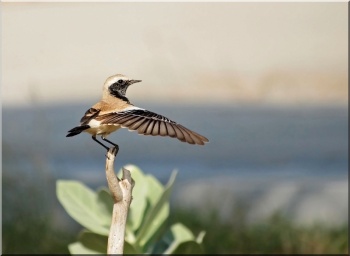
Photo © by Alok Tewari
Jamnagar, Coastal Gujarat, India, 20 January 2016
- Oenanthe deserti
Identification
14-15.5 cm (5½-6 in)
Male
- Buff above
- White below
- Buff hue to breast
- Black face, throat and shoulders
- White superciliary stripe
- Tail is nearly all black, giving appearance of only a white rump (similar Wheatears have mostly white tails with black band)
Female
- Greyer upperparts
- More buff underparts
- Throat not black
Distribution
Breeds across North-West Africa from north Mauritania to central Tunisia, north-east Libya and Cyrenaica, in northern Egypt and Sinai. In the Middle East breeds in south Syria, north-west Iraq and north-east Jordan and in Israel and adjacent western Jordan, and also in northern Saudi Arabia. Recently discovered breeding in southern Turkey. Outside the Western Palearctic region breeds across Asia to northern China.
Partially or fully migratory, some populations resident. Northernmost birds tend to be more migratory and winter range extends from Sahara to the Horn of Africa, and from Arabia to north-west India.
Fairly frequent vagrant outside normal range recorded north to Britain, France and Belgium, Netherlands, Germany and Scandinavia, most European Mediterranean countries (annual on Sicily) and also Spain, Portugal, Madeira and the Canary Islands.
British records (132 up to the end of 2012) are well scattered from Shetland to Scilly but the majority on the east and south coasts, recorded in most months but peaks in March-April and September-November; there have been several instances of birds overwintering.
Taxonomy
Subspecies
Four races are recognised but field separation is difficult[1]
- North African race O. d. homochroa is most distinctive with pale sandy-coloured plumage
- O. d. deserti resident in northeastern Egypt (Sinai) and the Levant; breeding from southern Turkey east, discontinuously, to Afghanistan, central and southern Kazakhstan, Mongolia, and northwestern and western China (northwestern Xinjiang, Gansu, Shaanxi, and central Inner Mongolia); wintering in northeastern Africa (including Socotra) and southwestern Asia
- O. d. oreophila is found from western China to Kashmir and Tibet; wintering to Pakistan and north-eastern Africa
Habitat
Breeds on dry, sandy steppe-like heath or in semi-desert with scattered bushes, low vegetation and rocks (but shuns pure sand desert).
Sandy or stony plains and steppes and semi-desert with scrub, often in areas of abandoned cultivation. In winter often coastal areas. Vagrants often occur around reservoirs.
Behaviour
Short-distance migrant.
Diet
Their main diet consists of invertebrates, including adult and larval beetles. They also occasionally take seeds
Breeding
They nest in hole in ground or in rock crevice.
References
- Clements, J. F., T. S. Schulenberg, M. J. Iliff, S. M. Billerman, T. A. Fredericks, J. A. Gerbracht, D. Lepage, B. L. Sullivan, and C. L. Wood. 2021. The eBird/Clements checklist of Birds of the World: v2021. Downloaded from https://www.birds.cornell.edu/clementschecklist/download/
- Handbook of the Birds of the World Alive (retrieved Dec 2017)
- Wikipedia
Recommended Citation
- BirdForum Opus contributors. (2024) Desert Wheatear. In: BirdForum, the forum for wild birds and birding. Retrieved 16 April 2024 from https://www.birdforum.net/opus/Desert_Wheatear
External Links
GSearch checked for 2020 platform.1





